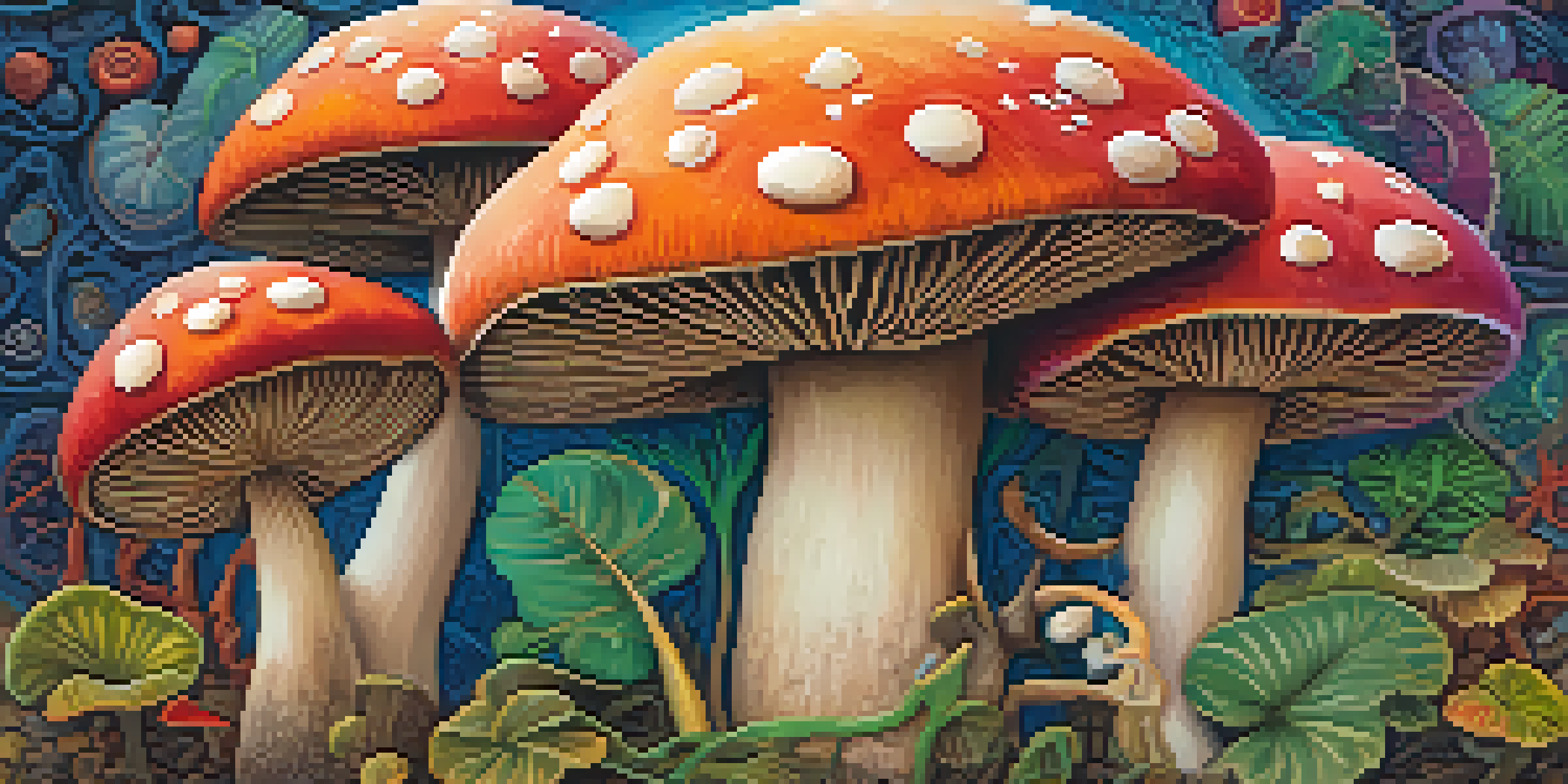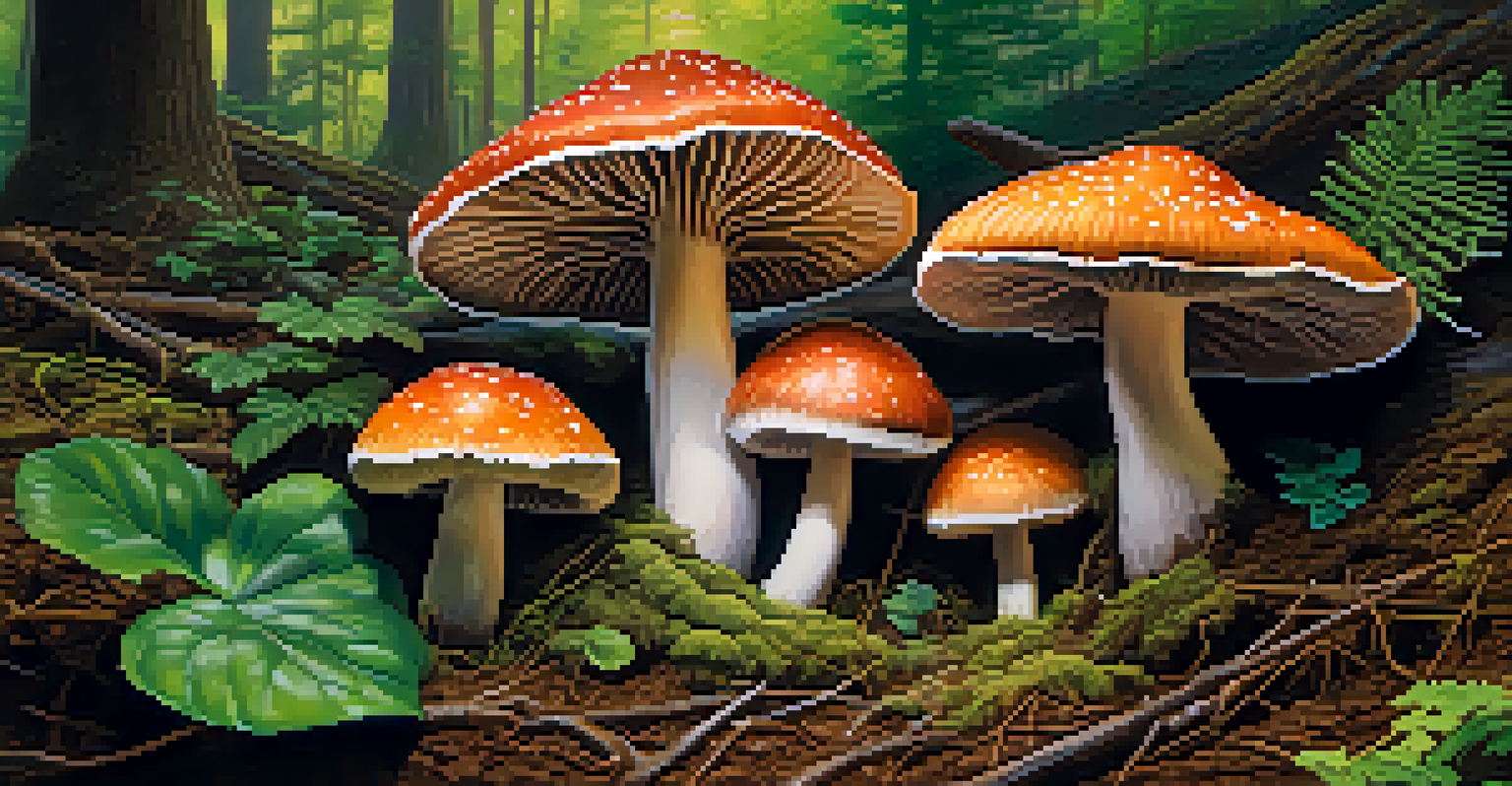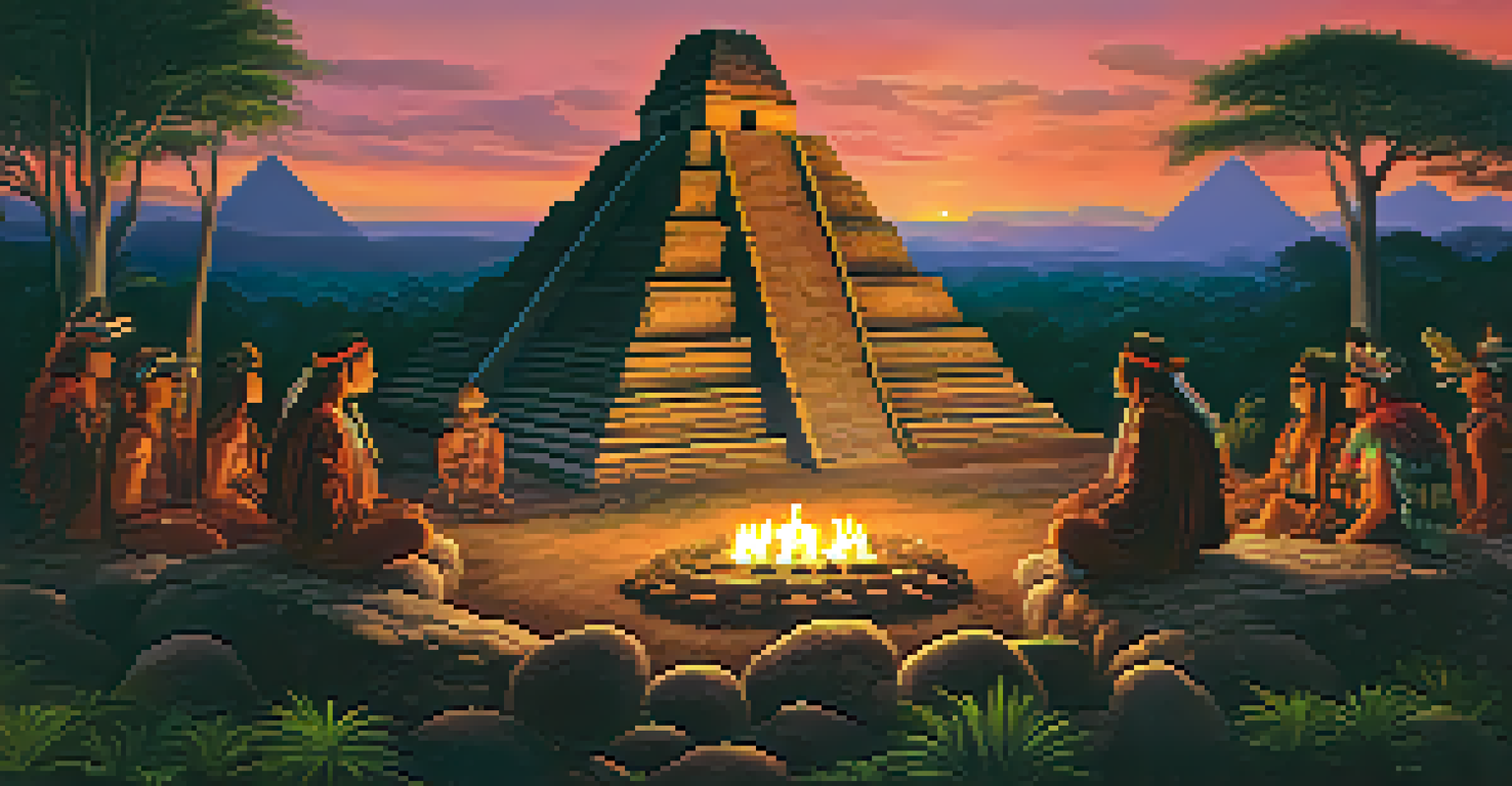The Sacred Mushroom: Historical Use in Mesoamerican Cultures

The Role of Sacred Mushrooms in Ancient Rituals
In Mesoamerican cultures, sacred mushrooms, particularly those containing psilocybin, played a vital role in spiritual rituals. These mushrooms were often consumed during ceremonies to connect with the divine, allowing shamans to gain insights and communicate with deities. The use of these fungi was not merely recreational; it was deeply intertwined with the cultural fabric of societies like the Aztecs and the Maya.
Mushrooms are the most mysterious and magical of all plants. They have a deep connection to the earth and the heavens, serving as a bridge between the two worlds.
The mushrooms were considered gifts from the gods, believed to facilitate healing and enlightenment. For instance, the Aztecs referred to them as 'teonanácatl,' translating to 'flesh of the gods.' This reverence highlights the mushrooms' importance in religious context, as they were seen as a bridge to higher realms and spiritual truths.
Through the consumption of these sacred mushrooms, individuals experienced altered states of consciousness, which were integral to their understanding of the universe. This practice underscores a profound relationship between humans and nature, exemplifying how ancient civilizations sought to explore the mysteries of existence.
Historical Evidence of Mushroom Use in Mesoamerica
Archaeological discoveries have provided compelling evidence of mushroom use in Mesoamerican societies. Cave paintings and artifacts dating back thousands of years depict mushrooms, suggesting their significance in early human rituals. These findings not only highlight the antiquity of mushroom use but also provide a glimpse into the spiritual practices of ancient peoples.

Additionally, codices and historical texts from the Aztecs and Maya describe rituals involving mushrooms and their effects. The Florentine Codex, compiled by the Spanish Franciscan friar Bernardino de Sahagún, documents the use of these fungi in religious ceremonies, offering rich insights into their cultural importance. This documentation demonstrates the continuity of mushroom-related practices through generations.
Sacred Mushrooms in Ancient Rituals
In Mesoamerican cultures, sacred mushrooms like psilocybin were integral to spiritual rituals, facilitating a connection with the divine.
Such historical narratives are crucial for understanding how sacred mushrooms influenced societal norms and spiritual beliefs. They reveal a complex interplay between culture, religion, and the natural world, showcasing the integral role these mushrooms played in shaping Mesoamerican identity.
Mushroom Symbolism in Mesoamerican Art and Mythology
Mushrooms appear prominently in Mesoamerican art and mythology, symbolizing fertility, transformation, and divine connection. Artifacts often showcase mushrooms in intricate designs, reflecting their significance in various cultural narratives. These depictions serve not only as artistic expressions but as reminders of the spiritual journeys undertaken by shamans and their communities.
Nature is not a place to visit. It is home. We need to restore the bonds that connect us to the natural world.
In mythology, mushrooms are frequently associated with creation stories and the underworld. For instance, some myths depict the mushroom as a symbol of rebirth, linking it to the cyclical nature of life and death. This association illustrates how deeply integrated mushrooms were in the metaphysical beliefs of these cultures.
By examining these artistic and mythological representations, we gain a deeper appreciation of how sacred mushrooms were woven into the very fabric of Mesoamerican life. They were not just substances consumed but powerful symbols that resonated with the spiritual and existential questions faced by these societies.
Shamanic Practices and the Use of Mushrooms
Shamans in Mesoamerican cultures were the primary practitioners of mushroom consumption, using them as tools for divination and healing. These spiritual leaders would guide their communities through rituals that involved ingesting mushrooms to achieve altered states of consciousness. In these states, shamans believed they could access knowledge and insights unavailable during normal waking hours.
During ceremonies, shamans often prepared special contexts for mushroom use, creating a sacred space filled with intention and focus. This careful preparation highlights the importance of mindset and environment in the effectiveness of the experience. The communal aspect of these rituals further emphasized the interconnectedness of individuals and their shared spiritual journeys.
Modern Interest in Mushroom Use
There is a growing contemporary focus on the therapeutic benefits of sacred mushrooms, alongside the need to respect their cultural origins.
The role of shamans as mediators between the physical and spiritual worlds underscores the significance of mushrooms in Mesoamerican culture. Their practices demonstrate a sophisticated understanding of consciousness and the human experience, illustrating how these ancient societies navigated the complexities of life through spiritual exploration.
Modern Perspectives on Sacred Mushrooms
In contemporary times, there has been a resurgence of interest in the use of sacred mushrooms, not only for their historical significance but also for their potential therapeutic benefits. Many researchers are exploring how compounds like psilocybin can aid in treating mental health issues such as depression and anxiety. This renewed focus has brought ancient practices into the modern wellness conversation.
Furthermore, the cultural appropriation of these practices raises important ethical questions. While many seek to understand and integrate these ancient traditions into their lives, it is crucial to respect and honor the origins and meanings of these rituals. Engaging with indigenous communities and understanding their perspectives is essential to ensure that these practices are preserved authentically.
The modern exploration of sacred mushrooms serves as a bridge between past and present, highlighting their timeless relevance. As societies grapple with mental health challenges, the ancient wisdom surrounding mushroom use offers valuable insights into holistic approaches to well-being.
The Ecological Importance of Sacred Mushrooms
Beyond their spiritual significance, sacred mushrooms play an essential role in the ecosystems of Mesoamerica. As decomposers, they contribute to nutrient cycling, enriching the soil and fostering plant growth. This ecological role mirrors the interconnectedness emphasized in Mesoamerican beliefs, where all elements of nature are seen as interdependent.
Mushrooms also serve as a food source for various wildlife, highlighting their importance in maintaining biodiversity. The presence of these fungi indicates a healthy ecosystem, as they thrive in environments rich in organic matter. This ecological perspective reinforces the idea that respecting and preserving natural habitats is vital for sustaining both cultural and biological diversity.
Ecological Role of Sacred Mushrooms
Sacred mushrooms contribute significantly to ecosystems as decomposers, highlighting the interconnectedness of nature emphasized in Mesoamerican beliefs.
Understanding the ecological importance of sacred mushrooms enriches our appreciation of their role in Mesoamerican cultures. It reminds us that these ancient practices are not just about spirituality but also about living in harmony with the environment, an ethos that remains relevant today.
Preservation of Ancient Mushroom Traditions
As interest in sacred mushrooms grows, so does the need to preserve the ancient traditions surrounding them. Efforts to document and revitalize these practices are underway, often led by indigenous communities themselves. These initiatives aim to ensure that the knowledge and significance of sacred mushrooms are passed down through generations.
Education and awareness are essential components of this preservation. By sharing the history and cultural context of mushroom use, we can foster greater appreciation and respect for these practices. This not only honors the ancestors but also empowers current and future generations to engage thoughtfully with their heritage.

Ultimately, preserving ancient mushroom traditions is about safeguarding cultural identity and ecological wisdom. As we navigate the complexities of modern life, these age-old practices offer valuable lessons in spirituality, community, and our relationship with the natural world.